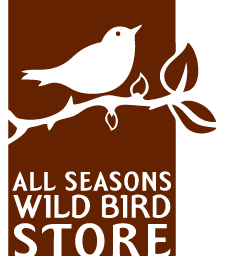Spring seasonal tips
Your Spring Backyard Checklist
- Use the Best Nest Builder, made of cotton fibers, to provide nesting material.
- Put out at least 2 bird houses, one for wrens and one for chickadees. Best practice is to hang them from a pole and put a squirrel baffle on the pole 4 ¼’ to 5’ off the ground.
- Offer mealworms to help the adults feed their young. Orioles feed their young caterpillars and are especially attracted to mealworm feeders while young are in the nest.
- Use calcium-rich suet during egg laying time such as Pacific Bird and Supply suet cakes and Attractor nutritional suet plugs in various flavors.
- Cardinals have difficulty eating from a suet cage but will feed their young suet pellets and dried or live mealworms when offered in a dish, tray or platform.
- Use liquid nectar with Nectar Defender already added to keep your nectar fresh longer. Great for use at the cabin when larger capacity nectar feeders will be unattended for a week.
- Attract orioles with nectar (change every three days), oranges, mealworms and grape jelly. Put feeders out the last week of April.
- Do not use Kool-Aid, honey, or artificial sweeteners in nectar feeders. Easy to use nectar concentrate is available for purchase in liquid or powder. Put feeders out the last week of April.
- Keep ants out of the nectar by hanging a feeder from an ant moat filled with water or an Antguard ® which repels ants.
- Deter bees from feeders by rubbing mint leaves or mint extract on the nectar ports.
- Scrub the birdbath with 9 parts water to 1 part bleach. Rinse well. For a safe and healthy bird bath add Bird Bath Protector to the just cleaned bath.
- The Water Wiggler attracts more birds to a bird bath and prevents mosquitoes from laying their eggs by moving the water constantly.
- Store seed in the freezer or outside the house (in metal containers ) to avoid moths. Hang a moth trap, available at our stores, near seed containers in the garage.
- Use Golden Safflower to avoid attracting grackles, and starlings while still attracting cardinals, goldfinches, chickadees and house finches.
- To avoid attracting starlings while still providing a bird seed mix Bye, Bye Starling.
- Prevent just-fledged juvenile birds from hitting your windows by applying Window Alerts.
- Found a baby bird? If it is sparsely feathered and not capable of hopping, walking, flitting or gripping tightly to your finger it is a nestling. Look for the nearby nest and put the bird back in the nest or put it on a protected branch. If the bird is feathered and capable of hopping and flitting it is a fledgling and should be left alone. The parents are nearby and are watching and feeding the fledgling.
- Found an injured bird? Contact the Wildlife Rehab Center at 651-486-9453. wrcmn.org
- Plan to add berry-producing plants like high bush cranberry, plants for cover like arborvitae and seed producing plants like purple cone flower and sunflower to your backyard.

Rub mint leaves or mint extract on nectar ports to deter bees from feeders.
Spring Observations
- Meteorologists tell us spring begins on March 1 in Minnesota but astronomers say spring begins on March 20, the vernal equinox
- One of the first signs of spring are the flocks of migrating Tundra swans and Snow geese flying high overhead beginning in early March.
- Pairs of Canada Geese are reclaiming nest sites in early March. Egg laying won’t begin until there is open water nearby.
- The first of the year returning Killdeer, Song Sparrows, Brown-headed Cowbirds and Common Grackles are often spotted the third week of March.
- By the end of March, it sounds like spring with Red-wings trilling and the vocalizations of Eastern Phoebes and Song Sparrows. Listen for Western Chorus frogs calling from grassy ponds and roadside ditches.
- Sandhill Cranes and Meadowlarks return or migrate through the area.
- April is our windiest month.
- Female American Robins return about a month after the males. Now the males are singing with gusto! Eastern Bluebirds are looking for nesting sites.
- In early April, Leopard frogs and Painted turtles emerge and Belted Kingfishers and Loons begin returning to area lakes. Wood ducks are laying eggs.
- In mid-April, Egrets, White Pelicans and Mallards have returned as have Chipping Sparrows, Yellow-rumped Warblers, Fox Sparrows, Hermit Thrushes and Tree Swallows. Black-capped Chickadees are nesting.
- Later April marks the return of the House Wren, Brown Thrashers and Barn Swallows.
- Migrating Orioles and Ruby-throated hummingbirds often arrive in the metro area the last week of April.
- Early May marks the return of many warblers, Scarlet Tanagers, Rose-breasted Grosbeaks and greater numbers of Orioles and Ruby-throated hummingbirds.
- Robin eggs are hatching and goslings follow the adult Canada geese to eat grass.
- Blue Jays and Northern Cardinals are incubating eggs.
- By mid-May Gray Catbirds and Indigo Buntings have arrived and warbler migration is at its peak.
- Red-eyed Vireos are easier to hear than see as they begin singing in the forests.
- Late May sees the return of Orchard Orioles, Common Nighthawks, Eastern Kingbirds, Least Flycatchers and Eastern Wood Pee Wees. The arrival of the Eastern Wood Pee Wees means the spring bird migration is coming to a close.


